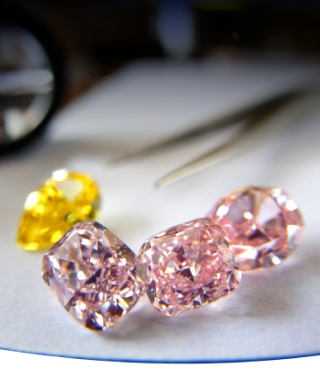Magnificent Jewels and Noble Jewels
Pre-Auction Analysis: November 9th, 2022, Sotheby’s Geneva, Magnificent Jewels and Noble Jewels
Our Sotheby’s Geneva Pre-Auction Analysis focuses on elements that are not always visible to the untrained eye. We discuss characteristics such as Inner-Grade, Color Dispersion, and Undertone – collectively termed IDU. Professionals use the IDU method intuitively when analyzing a Fancy Color Diamond. The acronym we use makes these elements easier to remember.
Members who read this analysis should see it as a valuable supplement to the GIA report. A detailed explanation of the FCRF’s grading methodology can be found at the end of this article. We recommend reviewing it closely to broaden one’s professional vocabulary for describing fancy color diamonds to clients.
Please note that we analyze and grade diamonds under LED lights and relative to their grade on the GIA report.
The Grades
We use grades 1, 2, 3, and 4, with 1 being the lowest grade. Grade “4+” is granted in rare cases and denotes stones with exceptional characteristics. Stones that receive a minimum total IDU score of 9 without a red remark pass the industry premium threshold and can be traded easily. Fancy Color Diamonds that are graded 10 or above (without a quality remark) are usually sought after by high-end jewelers and collectors.
For your convenience, we have added direct links to diamonds’ GIA reports and FCRF rarity stats.
- All images in this analysis were taken with an iPhone 13 Pro; no filters were applied.
- All auction valuations are per-carat and listed in US Dollars.
Disclaimer
This analysis reflects the opinions of the FCRF professional team. It does not constitute a recommendation to buy or not buy a particular diamond. Buyers assume the responsibility of verifying any information with the auction house. At times, mistakes can happen in the visual analysis and report placement. Therefore, one should not rely solely on this analysis for buying purposes.
__________________________________________________________________________
Lot: 266
Description: 1.90 ct, Fancy Vivid Green-Yellow, Oval, SI2
High Auction Estimation: $ 42,171 pc
Price realized: $30,348 pc
GIA Report: View
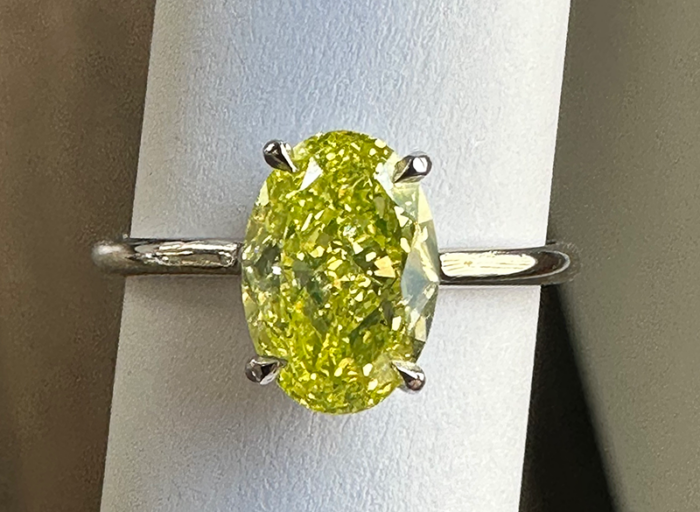
Analysis:
A 1.90 Fancy Vivid Yellow Green Oval-cut diamond, SI2 clarity. Diamonds with a phosphorescent appearance usually have a higher demand than similar yellow green diamonds that don’t have this unique color sensation. In this case, the phosphorescence is prominent and positively affects the Undertone. The Inner-Grade is solid with small colorless patches on the crown. The SI2 clarity results from two large black crystals. The stone’s fluorescent is Strong Blue but doesn’t seem to have a negative effect on the light refraction nor on the color.
Visual Assets:
Inner Grade..……………….3
Color Dispersion.………4
Undertone..…………………4
Total Visual Score….11 out of 12
Quality remark: SI2, strong blue fluorescent.
__________________________________________________________________________
Lot: 292
Description: 5.01 ct, Fancy Orangy Pink, Pear, VS2
High Auction Estimation: $ 480,909
Price realized: $153,329 pc
GIA Report: View
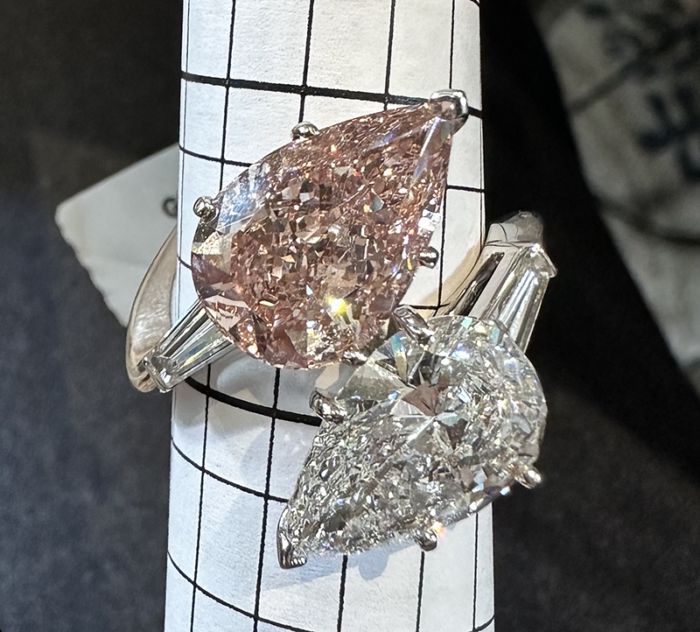
Analysis:
This analysis refers to the 5.01 Orangy Pink only and the price we report reflects the total price of the ring.
This 5.01 ct Fancy Orangy Pink exhibits a typical warm color sensation as expected from most pink diamonds, with a 15% orange modifier in their color mix. The diamond’s Inner-Grade is high, as is its color dispersion.
*Side Note about color and lighting:
The color temperature of this stone changes significantly when it is viewed under different light sources.
Visual Assets:
Inner Grade..……………….4
Color Dispersion.………3
Undertone..…………………3
Total Visual Score….10 out of 12
__________________________________________________________________________
Lot: 293
Description:
10.92 ct, Fancy Yellow, Radiant, VS1
2.43 ct, Fancy Yellow, Radiant, VS2
2.17 ct, Fancy Yellow, Radiant, VVS1
High Auction Estimation: $ 16,443 pc
Price realized: $11,550 pc
Rarity 10.92: 6-11 diamonds yearly – Share this rarity result – Here
Rarity 2.43: 90-120 diamonds yearly – Share this rarity result – Here
Rarity 2.17: 40-53 diamonds yearly – Share this rarity result – Here
GIA Report 5221523081: View
GIA Report 2221526143: View
GIA Report 5222526148: View
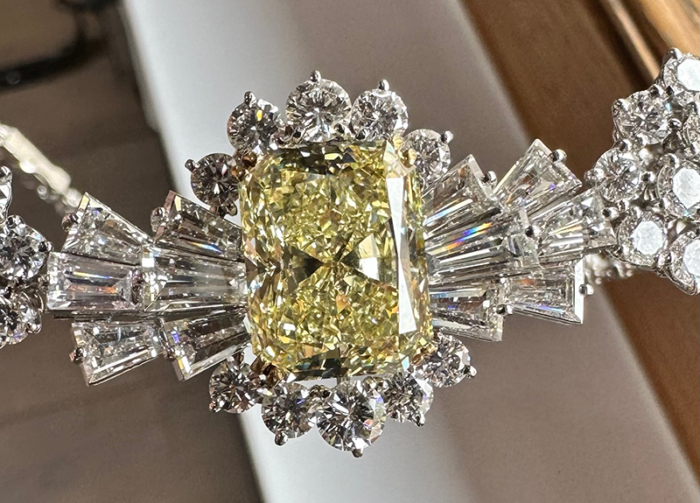
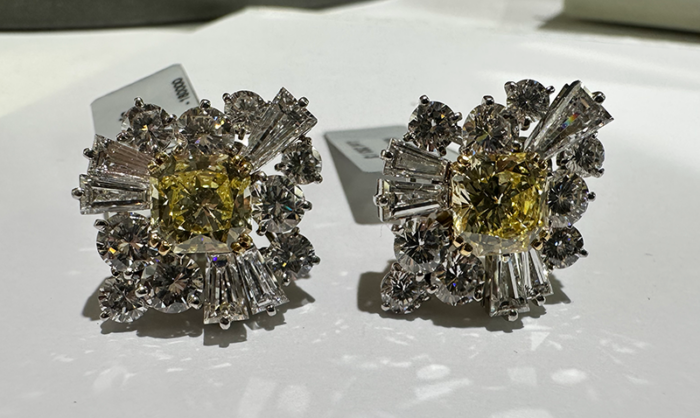
Analysis:
A set of three fancy yellow diamonds with old style facet arrangement. All three stones were manufactured somewhere between the 1980-1990s, without an emphasis on color dispersion. The 10.92 fancy yellow radiant cut has a large colorless bow-tie under the table and its Inner-Grade is weak. The 2.43 ct. and the 2.17 ct. have a better Inner-Grade but exhibit poor color dispersion
Visual Assets for the 10.92:
Inner Grade..……………….2
Color Dispersion.………2
Undertone..…………………3
Visual Assets for the 2.43 and 2.17:
Inner Grade..……………….3
Color Dispersion.………1
Undertone..…………………3
Total Visual Score….7 out of 12
Total Visual Score….7 out of 12
Quality remark: Poor dispersion.
__________________________________________________________________________
Lot: 295
Description: 10.89 ct, Fancy Yellow, Round, VVS2
High Auction Estimation: $ 16,529 pc
Price realized: $17,630 pc
Rarity: Once every 1-2 years – Share this rarity result – Here
GIA Report: View
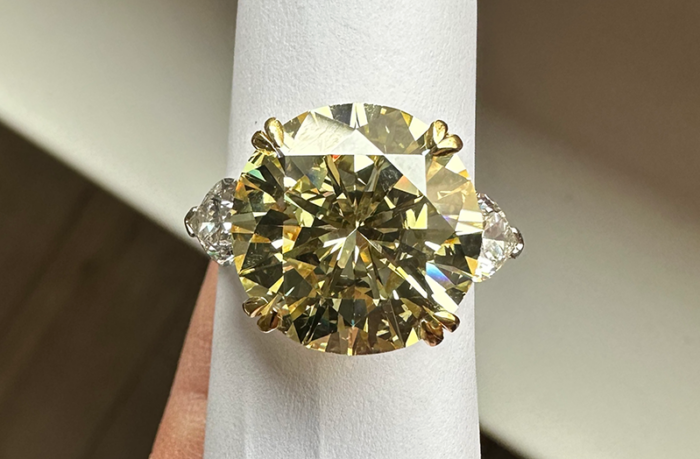
Analysis:
A 10.89 Fancy Yellow Round Brilliant-cut with VVS2 clarity. Looking at the facet alignment (table size and pavilion), we can assume it was manufactured somewhere in the middle of the last century. Aside from a small number of yellow flashes of color on the face up view, it does not meet the color expectation of a modern modified fancy yellow diamond. A classic round cut will not fulfill the stone’s color potential, and in most cases, will achieve one full saturation mark lower than a modified square or fancy shape. In the video, we can clearly see the amount of color under the crown when tilting the stone to the side, an indication of the stone’s potential had it been cut as a modified in any other shape.
No significant green or brown undertone is seen in the color, and color dispersion is typical of a classic round diamond.
*Side note about Rarity:
The rarity result may seem odd to professionals who see quite a few preowned large yellow round diamonds each year. However, these stones are re-polished into other shapes to achieve a stronger saturation before being submitted to the GIA, and there is therefore no record of them. This rarity result refers to the very few preowned yellow rounds that enter the market after being submitted to the GIA in their original shape.
Visual Assets:
Inner Grade..……………….1
Color Dispersion.………2
Undertone..…………………3
Total Visual Score….6 out of 12
Quality Remark: Low dispersion and Inner-Grade
__________________________________________________________________________
Lot: 299
Description: 4.05 ct, Fancy Vivid Yellow, Emerald, VS2
High Auction Estimation: $ 44,421 pc
Price realized: $44,236 pc
Rarity: 12-14 diamonds yearly – Share this rarity result – Here
GIA Report: View

Analysis:
A 4.05 Fancy Vivid Yellow Emerald-cut diamond with a strong Inner-Grade and a soft and desirable orange Undertone. Although the four corners on the pavilion were not enlarged, as seen in most fancy color step-cut diamonds, color is dispersed quite well for an Emerald cut.
Visual Assets:
Inner Grade..……………….3
Color Dispersion.………3
Undertone..…………………3
Total Visual Score….9 out of 12
__________________________________________________________________________
Lot: 331
Description: 4.47 ct, Fancy Gray-Violet, Radiant, IF
High Auction Estimation: $ 671,255 pc
Price realized: Didn’t reach the minimum
GIA Report: View

Analysis:
A 4.47 Fancy Gray Violet Radiant-Cut. This is an extremely rare color grade for a diamond of this size. According to the facet alignment on the pavilion and the large cut corners, the stone was re-cut from what used to be a round brilliant. It seems that due to the strong presence of gray in the color, the bare minimum was done during the re-cut in order to concentrate the color and probably to avoid receiving a grade of deep from the GIA.
Analyzing the stone under standard diamond light and natural daylight, we can say that the stone’s color does not live up to its description on the GIA report and the violet hue is masked under a heavy layer of gray undertone.
*A side note about pricing:
When it comes to the price of fancy color diamonds with a very rare color combination but questionable aesthetic appearance, these diamonds tend to be acquired by passionate collectors rather than natural jewelry lovers, and as such, the price they achieve at auction doesn’t always correlate with their extreme rarity.
Visual Assets:
Inner Grade..……………….4
Color Dispersion.………2
Undertone..…………………1
Total Visual Score….7 out of 12
Quality Remark: Low color Dispersion and low undertone.
__________________________________________________________________________
Lot: 333
Description: 2.75 ct, Fancy Blue, Marquise, VS1
High Auction Estimation: $ 544,877 pc
Price realized: $843,886 pc
GIA Report: View
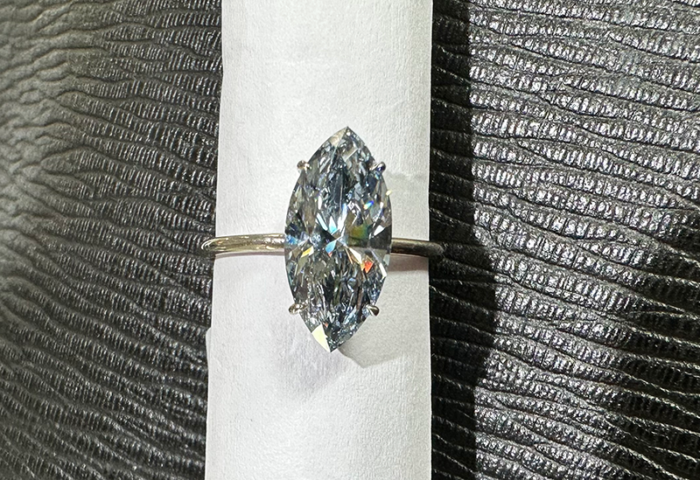
Analysis:
A 2.75 carat Fancy Blue Marquise that was cut and polished as a standard colorless diamond exhibiting very low color dispersion typical of the period in which it was manufactured (the middle of the previous century). Due to this insufficient facet alignment, a low Inner-Grade is seen mainly in the two pointy areas of the shape, which implies that it can be improved by modifying the shape to achieve a stronger Inner-Grade.
No gray undertone can be seen in the hue.
*Side note about photography:
Blue fancy color diamonds photographed on a white background with a smartphone tend to appear less blue than they are in reality.
GIA report dated 2016
Visual Assets:
Inner Grade..……………….3
Color Dispersion.………1
Undertone..…………………4
Total Visual Score….8 out of 12
Quality Remark: Poor color dispersion.
__________________________________________________________________________
Lot: 349
Description: 37.50 ct, Fancy Vivid Yellow, Pear, VS1
High Auction Estimation: $ 79,908 pc
Price realized: $65,159 pc
Rarity: Once every 3-4 years – Share this rarity result – Here
GIA Report: View
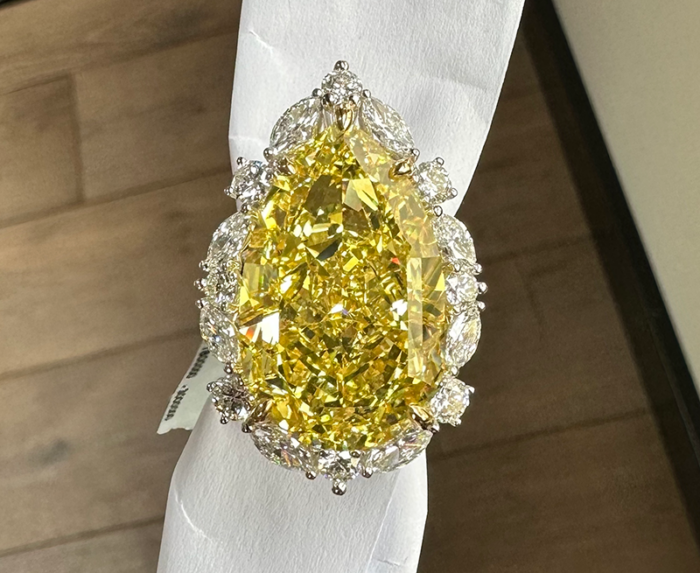
Analysis:
A very large Fancy Vivid Yellow Pear shape with very good color dispersion and a strong Inner-Grade. The undertone is insignificant, exhibiting an attractive yellow sensation.
The face-up surface of the diamond corresponds to a smaller diamond with a lesser carat weight. The side view on the video clearly shows the very high crown, which retains a significant amount of the diamond’s weight.
Visual Assets:
Inner Grade..……………….3
Color Dispersion.………4
Undertone..…………………3
Total Visual Score….10 out of 12
__________________________________________________________________________
Lot: 354
Description: 2.03 ct, Fancy Vivid Purplish Pink, Cushion, VS1
High Auction Estimation: $ 983,804 pc
Price realized: $810,955 pc
Rarity: Once every 3-4 years – Share this rarity result – Here
GIA Report: View
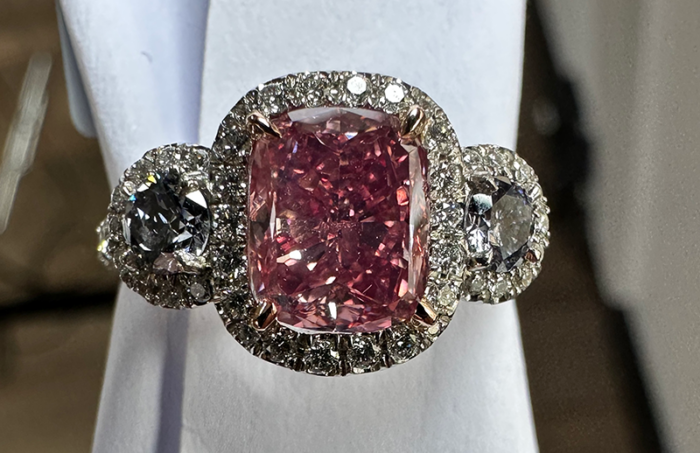
Analysis:
A 2.03 Fancy Vivid purplish pink cushion with very high visual assets. The diamond’s Inner-Grade is high, as is its color dispersion. The purple modifier creates an attractive color sensation as expected from a vivid pink diamond; however the 74% depth makes this two carat cushion shape appear smaller relative to its carat weight.
The strong blue fluorescence doesn’t seem to impact the stone’s light refraction nor its brilliance.
Visual Assets:
Inner Grade..……………….3
Color Dispersion.………4
Undertone..…………………4
Total Visual Score….11 out of 12
Quality remark: Strong Blue fluorescent and 74% depth.
__________________________________________________________________________
Lot: 360
Description: 5.53 ct, Fancy Vivid Blue, Cushion, VS2
High Auction Estimation: $ 2,706,170 pc
Price realized: Didn’t reach the minimum
Rarity: Once every 8-12 years – Share this rarity result – Here
GIA Report: View
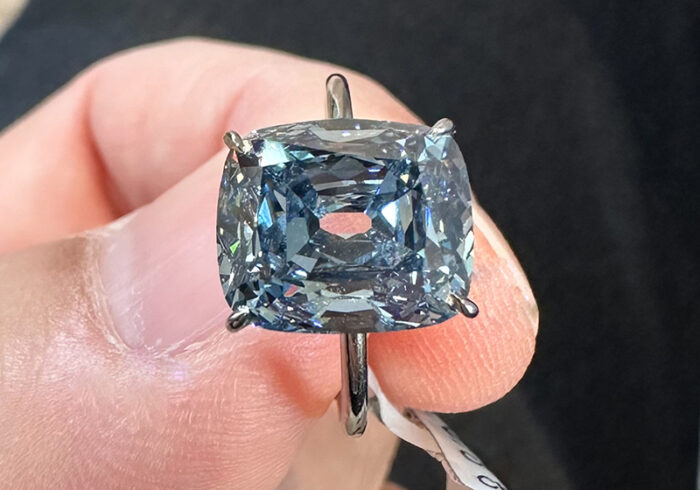
Analysis:
A Fancy Vivid Blue cushion imitating an Old-Mine cut diamond. Looking at the large open culet, we can assume that the piece of rough was quite shallow which dictated this relatively flat and periodical facet alignment. As a result, its surface area corresponds to a diamond with a higher carat weight.
The Vivid Inner-Grade (richness of color) is solid, and the amount of Gray undertone does not impact the blue sensation very much. Colorless patches are seen all over the face-up view but are inherent of this romantic shape and should not incur a discount.
*Side note about the girdle:
Buyers should be aware that a large section of the stone’s girdle is very thick, and the opposite side (significant as well) is thin. We mention this because it doesn’t correspond with a genuine Old-Mine cut and could be conspicuous once mounted in a high-end piece of jewelry.
Visual Assets:
Inner Grade..……………….3
Color Dispersion.………3
Undertone..…………………3
Total Visual Score….9 out of 12
__________________________________________________________________________
General
We use 1, 2, 3, 4, and 4+ to grade the three visual elements that GIA is silent about, although they impact the value dramatically.
Inner-Grade refers to the strength of color within each GIA saturation category:
Grade 1 weakest, bordering the saturation below.
Grade 2 weak (most common).
Grade 3 full-bodied color (above average).
Grade 4 very strong saturation.
Grade 4+ applies to the vivid category only, exhibiting the strongest possible saturation (rarely seen).
Undertone refers to a subtle hue influence in the body color of the stone.
For example:
A Fancy Blue Diamond with a significant gray presence in its general appearance will be graded with a low undertone grade of 1. A Fancy Blue that has no gray influence that is close to a primary blue will receive a grade of 4.
In a Pink Fancy Color Diamond, a stone with a warm undertone (such as orange or brown) will receive a low undertone grade. A pink stone with a cold undertone (such as purple) will receive a high grade.
In Yellow Fancy Color Diamonds, low foreign influence or a light orange influence will grant the stone a high undertone grade. When the yellow undertone looks like a true primary yellow, it will receive the rare grade 4+. Green and brown undertones will grant a low grade in the yellow category.
Color Dispersion relates to how well the color is dispersed in the face-up view of a Fancy Color Diamond, regardless as to whether the GIA grades the stone as even. A stone with many colorless areas will receive the grade 1, while a stone that exhibits its face-up view with no colorless patches will receive the grade 4+. Unlike the first two elements, color dispersion is not a gemological quality and is the result of cutter proficiency.


